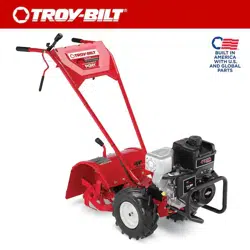Loading ...
Loading ...
Loading ...

10 Section 4— controlS & operation
• Each succeeding lower terrace is started by
walking below the terrace you’re preparing.
For added stability of the tiller, always keep
the uphill wheel in the soft, newly tilled soil.
Do not till the last 12” or more of the downhill
outside edge of each terrace. This untilled
strip helps to prevent the terraces from
breaking apart and washing downhill. It also
provides a walking path between rows.
Tilling across slopes without using terraces:
• If vertical or terracing gardening aren’t
practical for you, then you can till laterally
across a slope.
WARNING! This method is not
recommended as it can create unsure
footing and invites soil erosion.
• As in terrace gardening, start at the top of the
slope and overlap the first pass by half the
width of the tiller. For added stability of the
tiller, always keep the uphill wheel in the soft,
newly tilled soil.
Power Composting
Power composting simply means tilling through all
manner of organic matter, such as crop residues,
leaves, grass clippings and cover crops, burying
them in the soil. This material will decompose
during the non-growing season and add important
natural nutrients to the soil. It is best to follow the
proceeding guidelines when power composting.
WARNING! When power composting,
do not keep the depth regulator lever at
a deep setting if the tiller jumps or bucks.
If jumping or bucking occurs, move the
depth regulator lever down to one of the
shallower settings and then slowly
increase the tilling depth on later passes.
Failure to follow this warning could result
in personal injury.
• The first place to begin is with crop residues
such as leftover vines, stalks, stems and roots.
Power compost these crop residues as soon
as they finish bearing. The sooner this is done,
the better, as tender green matter is easier
to till into the soil. Use the deepest depth
regulator setting possible without causing
the engine to labor or the tiller to jump
ahead.
• Standing cornstalks of reasonable height
can be power composted. Pushing over, but
not uprooting, cornstalks will often make
it easier for your tiller to chop up the stalks.
Keep the tines clear of excessive tangling by
“fishtailing” or frequently using reverse. Make
several passes, then return a few days later to
finish off any straggling standers.
• After tilling under crop residues, add more
organic matter such as leaves, grass clippings
and even kitchen scraps. When tilled into the
soil, this organic matter will decompose and
add even more important nutrients to the
soil.
• After power composting, you may want to
plant a “green manure” cover crop to protect
the soil during the off-season. You simply
grow a crop of clover, alfalfa, buckwheat,
peas, beans, rye grass, grain, or kale and then
till it into the soil prior to the planting season.
Loading & Unloading the Tiller
WARNING! Loading and unloading
the tiller into a vehicle is potentially
hazardous and doing so is not
recommended unless absolutely
necessary, as this could result in personal
injury or property damage. However, if
you must load or unload the tiller, follow
the proceeding guidelines.
• Before loading or unloading, stop the engine,
wait for all parts to stop moving, disconnect
the spark plug wire and let the engine and
muffler cool. Remove the ignition key on
electric start models.
• The tiller is too heavy (over 170 lbs.,
depending on model) for one person to lift
safely. Two or more people should share the
load.
• Use sturdy ramps and, with the engine shut
off, manually roll the tiller into and out of the
vehicle. Two or more people are needed to
do this.
• Ramps must be strong enough to support
the combined weight of the tiller and any
handlers. The ramps should provide good
traction to prevent slipping, they should have
side rails to guide the tiller along the ramps
and they should have a locking device to
secure them to the vehicle.
• The handlers should wear sturdy footwear
that will help to prevent slipping.
• Position the loading vehicle so that the ramp
angle is as flat as possible. The less incline to
the ramp, the better. Turn the vehicle’s engine
off and apply its parking brake.
• When going up ramps, stand in the normal
operating position and push the tiller ahead
of you. Have a person at each side to turn the
wheels.
• When going down ramps, walk backward
with the tiller following you. Keep alert for
any obstacles behind you. Position a person
at each wheel to control the speed of the
tiller. Never go down the ramps tiller-first, as
the tiller could tip forward.
• Use wooden blocks to place on the downhill
side of the wheels if you need to stop the
tiller from rolling down the ramp. Also, use
the blocks to temporarily keep the tiller in
place on the ramps (if necessary), and to
chock the wheels in place after the tiller is in
the vehicle.
• When the tiller is in the vehicle, prevent it
from rolling by engaging the wheels in the
wheel drive position. Chock the wheels with
blocks and securely tie the tiller down.
Loading ...
Loading ...
Loading ...
